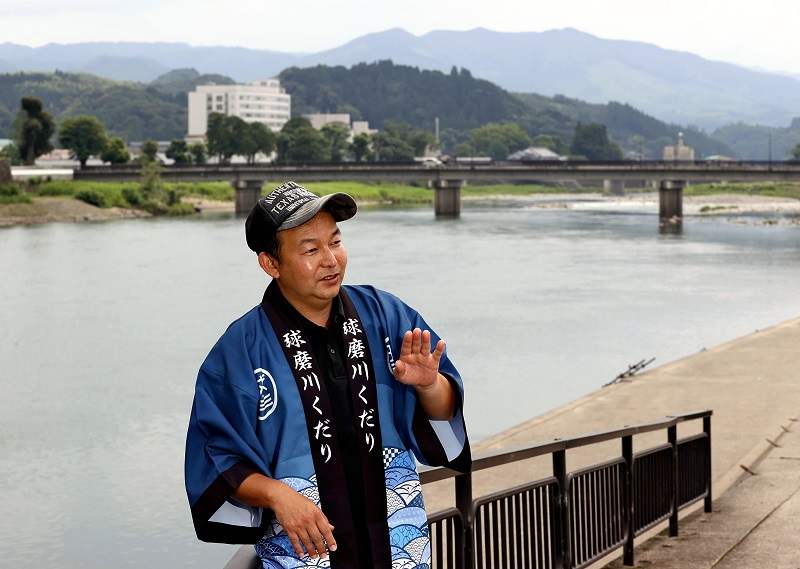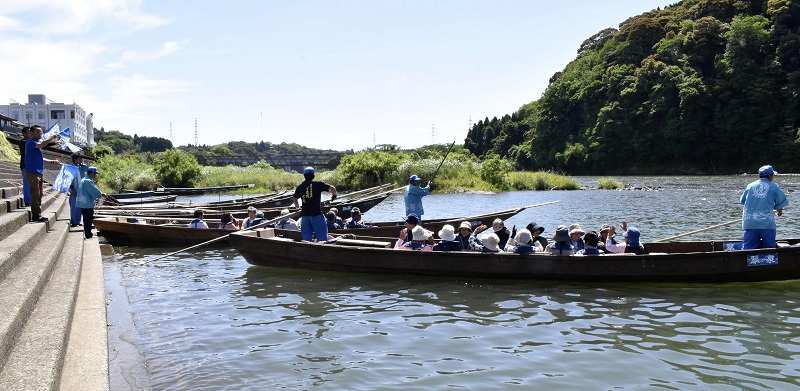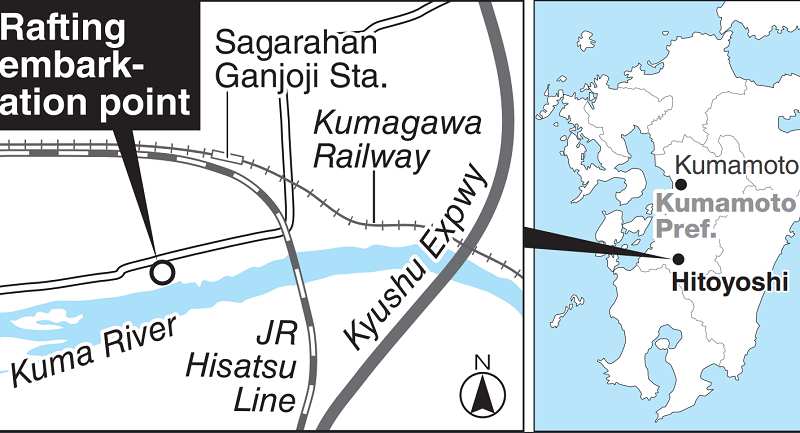
Boatman Kazuhiko Fujiyama speaks in front of the Kuma River in Hitoyoshi, Kumamoto Prefecture, on June 22.
10:57 JST, July 17, 2021
HITOYOSHI, Kumamoto — Rafting on the Kuma River, a famous tourist attraction in Hitoyoshi, Kumamoto Prefecture, will resume as early as late this month, after a yearlong suspension since torrential rains pounded the Kyushu region last July. For the sole remaining boatman of local tour company Riding the Kuma River Co., there was no choice but to get the business back afloat.

Boatmen and other staff shovel mud from the parking lot of the embarkation point in July 2020.
“I want to create an opportunity to rebuild this devastated area,” said Kazuhiko Fujiyama, 41, a Kuma River boatman with many years of experience.
The devastating torrential rains hit the area on July 4 last year. All 12 of the attraction’s boats were submerged, and half of them had to be scrapped.
On that fateful day, Fujiyama had rushed from his home to the rafting embarkation point, but the rising muddy waters made him fear for his life, so he drove to higher ground for shelter. When he came back after the waters had receded, he found that the boat depot had been inundated. One boat had even slammed into a warehouse about 5 kilometers away and was broken in half.
A mainstay of tourism in the region that had been in existence for more than 100 years was suddenly in grave danger. Fujiyama recalled those days, saying, “Since then, there were few things that made us genuinely smile.”
In addition to the loss of equipment, the topography of the river had been altered so greatly by the torrent of earth and sand that the safety of the tour route could not be assured. With loss of income a sudden concern, employees started leaving or retiring. The company’s roster of 12 decreased to only four.
Fujiyama grew up along a branch of the Kuma River and has long been involved with rafting. He began training as a boatman about 20 years ago. Immediately after the disaster, he took the lead in cleaning up the embarkation point.
In early June, two boats that had been repaired were transported by truck and returned to the embarkation point. The employees showed their biggest smiles of the year when the boats were unveiled.
Earlier this month, the operator opened a new boat depot. It was renovated into a tourist center with a cafe and a specialty store. About 20 people, including part-time workers, have been hired for the restart.
“River rafting is a symbol of our reconstruction. I want to be a boatman someday,” said Taihei Okamoto, 23, one of the new employees.
“The river may turn on us again, but we must be ready for any change,” Fujiyama said. “I want to overcome these difficulties together with my colleagues.”

A boat sails out with tourists aboard on the Kuma River in May 2019.
Rafting on the Kuma River has a history of over 100 years
At the end of the Meiji era in the early 20th century, the idea of river rafting to make use of the rapids of the Kuma River for tourism was conceived. After World War II, three competing companies merged to form a new company, what is now Riding the Kuma River Co. Since 1963, it has been a semipublic company. Business peaked in 1981, when about 137,000 people boarded the boats, but in recent years, the number has dropped due to diversification of way people spend their leisure time. Due to the spread of the novel coronavirus and the devastating 2020 torrential rains in Kyushu, the number of passengers dropped to about 130 in fiscal 2020.

Rafting embarkaion point
"Society" POPULAR ARTICLE
-

M4.9 Earthquake Hits Tokyo, Neighboring Prefectures
-

Israeli Tourists Refused Accommodation at Hotel in Japan’s Nagano Pref., Prompting Protest by Israeli Embassy and Probe by Prefecture
-

M7.5 Earthquake Hits Northern Japan; Tsunami Waves Observed in Hokkaido, Aomori and Iwate Prefectures
-

Tsukiji Market Urges Tourists to Avoid Visiting in Year-End
-

High School in Kyoto Says Students Shoplifted during Recent School Trip to Bali, Indonesia
JN ACCESS RANKING
-

Tokyo Economic Security Forum to Hold Inaugural Meeting Amid Tense Global Environment
-

Keidanren Chairman Yoshinobu Tsutsui Visits Kashiwazaki-Kariwa Nuclear Power Plant; Inspects New Emergency Safety System
-

Imports of Rare Earths from China Facing Delays, May Be Caused by Deterioration of Japan-China Relations
-

University of Tokyo Professor Discusses Japanese Economic Security in Interview Ahead of Forum
-

Japan Pulls out of Vietnam Nuclear Project, Complicating Hanoi’s Power Plans























